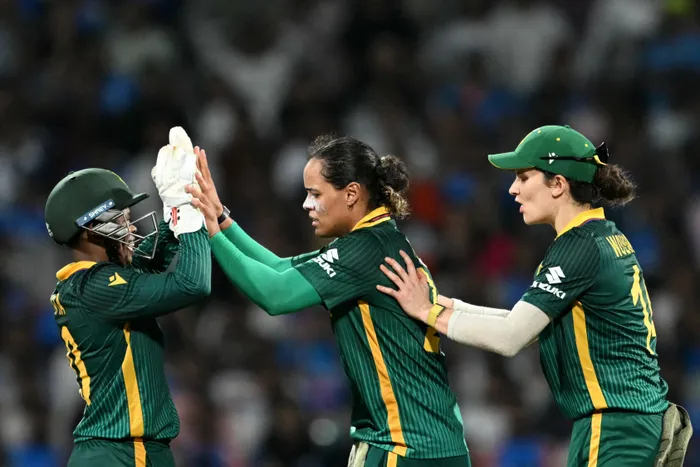Project 2029 begins now for Proteas Women's team after World Cup final disappointment
COMMENT

Proteas Women's captain Laura Wolvaardt literally pushed her team along at the recent ICC Women's World Cup, but will need greater support if they are to be successful in future. Picture: ICC
Image: ICC
COMMENT
Alas, another World Cup final, another Proteas Women’s heartbreaking defeat.
The format may be different, but that’s now three and counting. Forever the bridesmaids, never the bride. Perhaps the silver lining to all of this is that for years semi-finals were the immovable object. And as that obstacle was eventually overcome, so too will finals be conquered.
The Proteas’ entire World Cup campaign was a rollercoaster ride from start to finish, with captain Laura Wolvaardt admitting: “We were either really good or really bad, but thankfully there was a lot more really good throughout this tournament.”
It is worth remembering the Proteas’ build-up to this World Cup to gain a greater perspective though. They had won just seven out of their last 21 ODI’s, which included series’ losses to Australia and England, whilst also failing to make the final of a triangular series which included India and Sri Lanka.
Four of the seven victories were achieved against West Indies, who failed to qualify for the World Cup, and Pakistan that finished rock bottom at the recent jamboree.
Compare this to their form at the World Cup, where they beat each nation at some stage bar former champions Australia.
"We'll look back at this tournament as a lot of positives. I think at one stage we won five games in a row or something like that, which is pretty big for our group.
"Just searching for that consistency which is something that we don't necessarily have in bilaterals. So, really proud that we're able to perform in big tournaments,” Wolvaardt said.
For any team to win a World Cup, there has to be a synergy between the senior players excelling in the crunch moments, and the younger players contributing along the way.
Wolvaardt, of course, led from the front by breaking the record for the highest individual number of runs at a World Cup ever with 571, while Marizanne Kapp averaged a shade under 30 with the bat and claimed 12 wickets with the ball - just one below table-topper Nonkululeko Mlaba’s excellent 13 at 22.69.
There were also solid contributions from all-rounders Nadine de Klerk (208 runs, average 52, strike-rate 131.64, and 9 wickets) and Chloe Tryon (176 runs, average 29.33, strike-rate 89.79, and 6 wickets).
Senior batters such as Sune Luus (183 runs, average 30.50) and Tazmin Brits (235 runs, average 29.37) will know they were capable of much more. Brits, in particular, will reflect on a tournament that she had entered wanting to score three hundreds in the competition and had never previously been dismissed for a duck in ODIs.
Instead, she returned with three ducks and managed to score just one hundred.
After being messed around at the start of the competition by being left out of the playing XI for the first three matches, Annerie Dercksen (55 runs at 11.0) never quite got into her stride until the final, whilst Anneke Bosch’s (35 runs at 5.83) limited gametime leading into this World Cup due to injury was laid frightfully bare.
The experimentation with wicket-keepers Sinalo Jafta (92 runs at 15.33) and Karabo Meso interchanging at No 6 was fraught with danger throughout and placed the Proteas’ middle-order under constant pressure.
The contrast with India’s batting unit paints a clearer picture of the Proteas’ reality. Three of the world-champions boast tournament averages in excess of 50, two within touching distance of the 50-mark, and a further four in the 30s.
The bowling card is equally sombre. Nobody with the Proteas bowling unit comes even close to Deepti Sharma’s tournament-topping 22 wickets, while Shree Charani’s 14 is also better than Proteas’ top wicket-taker Mlaba.
The reality is that the Proteas over-achieved at this World Cup, largely due to their ‘Captain Fantastic’ Wolvaardt, De Klerk’s herculean strikes, Mlaba’s skill and Kapp’s once-off semi-final heroics, and that "Project 2029" needs to be put in place urgently ahead of the next World Cup in four years' time.
The time is ripe for a fresh blood to be infused into the side through consistent domestic performers such as Faye Tunnicliffe and Elize-Marie Marx, whilst talented youngsters such as Kayla Reyneke, Caitlin Wyngaard, Ayanda Hlubi and Seshnie Naidu need to be brought closer to the national team group, particularly with low key home series against Ireland and Pakistan on the horizon.
While the game has been professionalised at provincial level, women's cricket in South Africa is crying out for a franchise league competition in the mould of the men's Betway SA20.
If not, the wait for triumphant World Cup glory may stretch even longer.
Related Topics: